Queer theory defines queer as any transgression of social norms around sexuality, sexual expression and desire. They don’t necessarily believe in “identities”, but nevertheless they defend the legal institution of “identities”; see Judith Butler’s idea of “gender performativity”. They deny that sexuality is innate (a view which some radical feminists share, but from a very different perspective). Foucault stresses that homosexual orientation is a modern-day Western scientific social construct, that in history and non-Western cultures, homosexuality is considered an act or a (gender) role rather than an orientation or identity. See this illuminating article on how homosexuality is viewed in Saudi Arabia, which is the same way it is viewed in my culture, India (quoting the relevant part):
<<In The History of Sexuality, a multivolume work published in the 1970s and ’80s, Michel Foucault proposed his famous thesis that Western academic, medical, and political discourse of the 18th and 19th centuries had produced the idea of the homosexual as a deviant type: In Western society, homosexuality changed from being a behavior (what you do) to an identity (who you are).
In the Middle East, however, homosexual behavior remained just that—an act, not an orientation. That is not to say that Middle Eastern men who had sex with other men were freely tolerated. But they were not automatically labeled deviant. The taxonomy revolved around the roles of top and bottom, with little stigma attaching to the top. “‘Sexuality’ is distinguished not between ‘homosexual’ and ‘heterosexual’ but between taking pleasure and submitting to someone (being used for pleasure),” the sociologist Stephen O. Murray explains in the 1997 compilation Islamic Homosexualities: Culture, History, and Literature. 𝗕𝗲𝗶𝗻𝗴 𝗮 𝗯𝗼𝘁𝘁𝗼𝗺 𝘄𝗮𝘀 𝘀𝗵𝗮𝗺𝗲𝗳𝘂𝗹 𝗯𝗲𝗰𝗮𝘂𝘀𝗲 𝗶𝘁 𝗺𝗲𝗮𝗻𝘁 𝗽𝗹𝗮𝘆𝗶𝗻𝗴 𝗮 𝘄𝗼𝗺𝗮𝗻’𝘀 𝗿𝗼𝗹𝗲. A bottom was not locked into his inferior status, however; he could, and was expected to, leave the role behind as he grew older. “There may be a man, and he likes boys. The Saudis just look at this as, ‘He doesn’t like football,’” Dave, a gay American teacher who first moved to Saudi Arabia in 1978, told me. “It’s assumed that he is, as it were, 𝘁𝗵𝗲 𝗱𝗼𝗺𝗶𝗻𝗮𝗻𝘁 𝗽𝗮𝗿𝘁𝗻𝗲𝗿, 𝗽𝗹𝗮𝘆𝗶𝗻𝗴 𝘁𝗵𝗲 𝗺𝗮𝗻’𝘀 𝗿𝗼𝗹𝗲, and there is no shame attached to it.” Nor is the dominant partner considered gay.>>
The idea that “submitting to someone” and “being used for pleasure” is “a woman’s role” is not progressive. The idea that “taking pleasure”, using someone else for your pleasure, and domination are “a man’s role” is not progressive. This equation of dominance and masculinity, and submission and femininity, especially in a sexual context is what a radical feminist means by gender (and why we want to abolish it).
Saudi Arabia and India are both extremely patriarchal, brutally misogynistic countries, where gender roles are rigidly defined. The Indian third gender is a role for homosexual men in a rigid patriarchal society, and indeed, all third gender cultures are patriarchal, as I argue here. Western people should stand in solidarity with oppressed people – women and homosexuals – resisting oppression in formerly colonised countries, not romanticise or adopt regressive, patriarchal, homophobic traditions that exist here.
Evidence that queer theory is a movement for men’s sexual rights – that is, paraphilias, fetishes, and “kinks”; sadomasochistic sexuality based on eroticisation of domination and submission, degradation, and humiliation; grooming, violence, exploitation, and sexual abuse of children, women and other men:
• Queer theory is almost entirely based on the ideas of Michel Foucault in the two volumes of his History of Sexuality. Foucault is often referred to as “the Godfather of queer theory”.
Foucault started a petition to abolish the age of consent laws in France and legalise sexual relations between adults and children, because of views like this:
<< It could be that the child, with his own sexuality, may have desired that adult, he may even have consented, he may even have made the first moves. We may even agree that it was he who seduced the adult.>>
– The Danger of Child Sexuality, a dialogue between Michel Foucault, Jean Danet and Guy Hocquenghem,
It’s well worth reading the whole thing – these men defend paedophiles as victims of modern normative society and scientific discourse; say that nobody ever cared before if you “touched a child’s c*ck”; argue that child-adult “erotic relations” are an 𝘢𝘵𝘵𝘦𝘯𝘵𝘢𝘵 𝘴𝘢𝘯𝘴 𝘷𝘪𝘰𝘭𝘦𝘯𝘤𝘦, after which “even an anuscope can’t find any lesions”; and that we should find out whether or not the child consented by listening to them. The problem with the last idea is that paedophiles groom children and even groom society (and thus obtain a false “consent” from their victims), as you can see in the case of Jeffrey Epstein and Michael Jackson – the documentary Leaving Neverland is very, very illuminating.
It recently came out that Foucault abused Arab boys in Tunisia:
<<In an interview with the French public TV channel France 5 on March 5, Sorman confirmed that while visiting Foucault, he “witnessed what Foucault did with young children in Tunisia … ignoble things. The possibility of consent could not be sought. These were things of extreme moral ugliness.”
In a second interview with the British newspaper The Sunday Times on March 28, he recalled that “they were eight, nine, ten years old, he was throwing money at them and would say ‘let’s meet at 10pm at the usual place’”, a local cemetery in the town of Sidi Bou Said, north of the capital Tunis. “He would make love there on the gravestones with young boys. The question of consent wasn’t even raised.”>>
The writer of this article makes the important point that children in the Third World are dehumanised, and even “de-childed”, with arguments that they mature faster than Western children. These children are the most oppressed of the oppressed. Towards the end of this post, I will list facts and statistics about the commercial sexual exploitation of children (CSEC), which primarily affect children in the Third World, with Western child-sex-tourists being a significant portion of those who participate in the abuse. I also show the links between CSEC and adult prostitution. Progressives should stand in solidarity with the oppressed, not fight for the rights of oppressors. Queer politics argues that “sex work is work”, calling for full legalisation of prostitution, in order to destigmatise sex buyers, not prostituted women and children.
• The main forerunner of queer theory is the violent misogynistic pornographer and creator of the philosophy of “sadism” the Marquis de Sade:
<<In an era when both Church and State assigned gender roles and defined sexual practices in terms of male/female, lawful/illicit, Sade’s extensive accounts of sexual activity were categorized as deviant, prurient or provocative. William F. Edmiston explores how Sade’s unique challenge to sexual, moral and social taboos anticipates the discourses of queer theory.>>
• Georges Bataille, a writer and philosopher known for his violent, fetishistic pornography is another forerunner of queer theory:
“certain concepts of avant-garde thinker and writer Georges Bataille seem close to the heart of that queer resistance which seeks,among other things, to decenter the link between (hetero)sex and social progress and to rethink the relationship between sexuality, sexual citizenship and politics. As Michael Warner points out, Bataille can be seen as a direct precursor to this set of questions: ‘Some major branches of social theory have made the connection between sexuality and politics an important or even paradigmatic concern’, he states, citing among them ‘French social thought from Bataille to Deleuze’.5 In recent years, numerous titles have appeared that trace links between the philosophies of a range of continental (notably French) thinkers and the body of Anglo-American theory known as ‘queer’.6 Such projects can involve tracing an imaginative genealogy by recuperating thinkers whose work pre-dates and prefigures the advent of queer. However, no such volume or monograph has yet been dedicated to Georges Bataille. The aim of this article is to examine some of the key concepts associated with Bataille — namely dépense, transgression, and eroticism-as-death — and to investigate whether and to what extent they may meaningfully be situated in such a genealogy of queer thinking”
• Queer Theory Paedophilia Jeopardy with Derrick Jensen quotes from major queer theorists. Judith Butler says that incest (sexual abuse of children by family members) isn’t necessarily traumatic; the trauma is imagined or created due to society’s disapproval of it. Half of the founding document on queer theory by Gayle Rubin is devoted to a defence of “boylovers”. And more. He also asserts that no major queer theorist has strongly condemned paedophilia and argues that this paedophilia-apologism is driven by queer theory’s focus on “transgression”; it’s a short but illuminating video and I highly recommend watching it.
• The Trojan Unicorn: Queer Theory and Paedophilia – This essay quotes Foucault’s expression of amusement and approval of a man violently raping a girl child. But it makes many more points than that! It makes a convincing argument about the centrality of paedophilia-apologetics and paedophile rights activism to queer theory.
• Modern-day queer theorist Yasmin Nair defends neo-Nazi Milo Yiannopoulos after he was cancelled for defending child sex abuse, herself defending child sex abuse in the process.
Here, she argues for the centrality of kink to queer politics.
An article revealing Nair’s open defence of paedophilia:
<<In 2005, Current Affairs’ Editor-at-Large Yasmin Nair wrote that “The stigmatization of groups like NAMBLA (North American Man/Boy Love Association) which have asked for conversations about the age of consent means that we drive forms of desire inwards and underground.” In the same piece she claimed that “The conflation of pedophilia and pederasty with child molestation prevents us from considering a range of ways of responses and effects of sex between adults.” She went on to link to the website of the “International Pedophile and Child Emancipation (IPCE),” calling it simply “an organization.” That website’s homepage describes itself as “a forum for people who are engaged in scholarly discussion about the understanding and emancipation of mutual relationships between children or adolescents and adults.” Nair also wrote that “the problem with the current discussion around ‘adult-child’ relationships is that we are conditioned to think that sex with an older person is traumatic.”>>
• In the socialist magazine The Morning Star, Jacqui Dillon talks about her experience being viciously attacked and silenced by paedophiles attempting to rebrand and normalise paedophilia, making the connection between today’s MAPs (paedophiles rebranded to “Minor Attracted Persons”) and the Paedophile Information Exchange (PIE) of earlier decades.
• Another article revealing how paedophiles are attempting to gain acceptance.
• An academic article on the impact of queer theory on age of consent laws in the UK.
• Must read for a fuller context: Sheila Jeffrey’s book “Unpacking Queer Politics: A Lesbian Feminist Perspective”
And this informative talk: “Men’s Sexual Rights versus Women’s Sex-Based Right. WHRC Webinar 18th April 2020. Sheila Jeffreys“
Queer influence on social media, just a few examples (some of these I personally witnessed) – you can find many more:
• A heterosexual trans-identified man argues that kink is essential to the “identity” of heterosexual trans-identified men (“trans lesbians”):
<<It means segmenting our identities, telling us to leave parts of ourselves at home, even for the one day a year that’s ours. And as soon as we accept that as a community standard, then the line about what’s a kink and what’s an identity is gonna get moved real fast, just watch.
This year, it’s telling a trans lesbian they can’t walk her wives on leashes at Pride because it’s “not family appropriate,” even thought that’s what a lot of trans families looks like. In ten years, the demand might be that we come in boymode or not at all.>>
• Arthur Chu on Twitter: <<Children should be encouraged to see the accouterments of “fetishes” as a normal part of adult life, since they themselves will soon be adults and probably have their own “fetishes”>>
(Sorry, I didn’t archive this tweet; he has deleted it. I will try to find an archived version.)
• This person argues that Q in the LGBTQ includes straight kinksters, says that inclusion of fetishists is important because all groups in the acronym are connected by ‘non-normative sexual expression’: and calls themselves a representative of the wider LGBTQ community (and invites anyone who disagrees with this ideology to leave).
• Queer/trans community members defend the practice of adults buying children sex toys, and critics are prudes who harm children. A feminist describes the discourse she witnessed:
<<Buying adult sex toys for children was likened to being no different to giving chidlren the HPV inoculation. Just to be clear, sexual grooming was likened to being something that saves lives.
Women who objected to this were called prudish or problematic, or ill-informed. I’ve got to confess, it’s no surprise to me that every single account that joined in with this is a Mermaids supporter. Why might CSA abusers like an org that’s obsessed with chidlren giving consent?
This is exactly what happened in the 70s and 80s when the paedophile group PIE tried to use the gay rights movement to legitimise their cause. We are supposed to have learned from this. This is history repeating itself. We learned nothing.>>
• Self-identified MAP (“Minor Attracted Person”, i.e. paedophile) marched and spread “MAP positivity” at the Leeds Pride parade: (while lesbians holding “lesbian = female homosexual” and “lesbian not queer” banners are shouted at by the entire crowd with slogans like “I’d rather be a pervert than a TERF”). He had his account suspended but you can still see the replies at the original link.
• More “MAPs” arguing that the age of consent should be lowered and info on how they are lobbying to become part of the LGBTQ+ community:
“Trans-MAP Pride” twitter feels oppressed by delayed sex and consent education in babies
No, this isn’t a real Pride flag—it represents pedophiles
Disgustingly, paedophiles have created their own Pride flag
• r/antikink – A subreddit devoted to opposing the normalisation of kinks and fetishes, very informative.
• GNC Centric (a detransitioned woman and lesbian activist)’s testimony of being groomed as a child in online queer/trans communities: My Journey into online kink as a trans teen
• The very informative Twitter account of Jon K. Uhler, an expert on sexual predators
• r/itsafetish was a subreddit devoted to documenting evidence of autogynephilia – and often (auto)paedophilia or paraphilic infantilism – in mainstream online transgender spaces. It was banned during the great purge of gender critical communities by Reddit, despite being very well moderated and breaking no rules. The same information can be found on the facebook page It’s not a fetish tho.
Trans-identified autogynephilic male sexologist, Dr Anne Lawrence, who studies the etiology of male transsexuality, talks about the empirical evidence for autogynephilia here. A much more detailed account can be found in Lawrence’s book Men Trapped in Men’s Bodies.
A website run by members of the other group of trans-identified males, homosexual transsexuals, talks about how their identity was taken over by autogynephilic transsexuals here.
A website run by autogynephilic transsexuals estimates that the majority (80%) of trans-identified males in the West – and 3-15% of men in general – are autogynephilic.
• Very informative video on sissy hypno porn, autogynephiles’ misogynistic idea of womanhood equated with degradation and subordination, and transgender politics and identity.
Quotes from “Females”, by “the founder of the second wave of transgender studies” Andrea Long Chu, “Whipping Girl” by the foremost proponent of gender identity theory Julia Serano, trans male academic Grace Lavery, and “Sissy” by non-binary identified actor and writer Jacob Tobia:
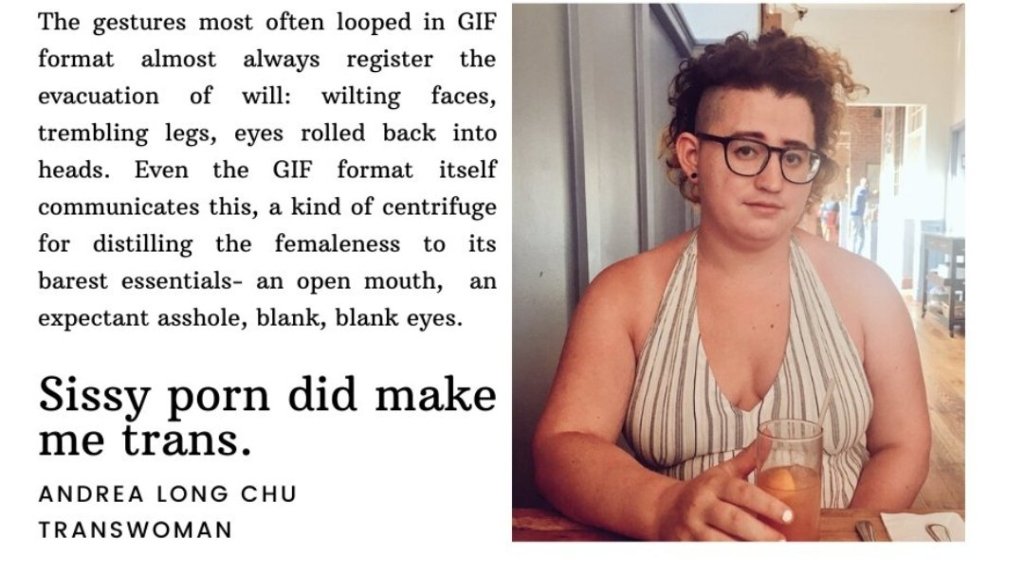
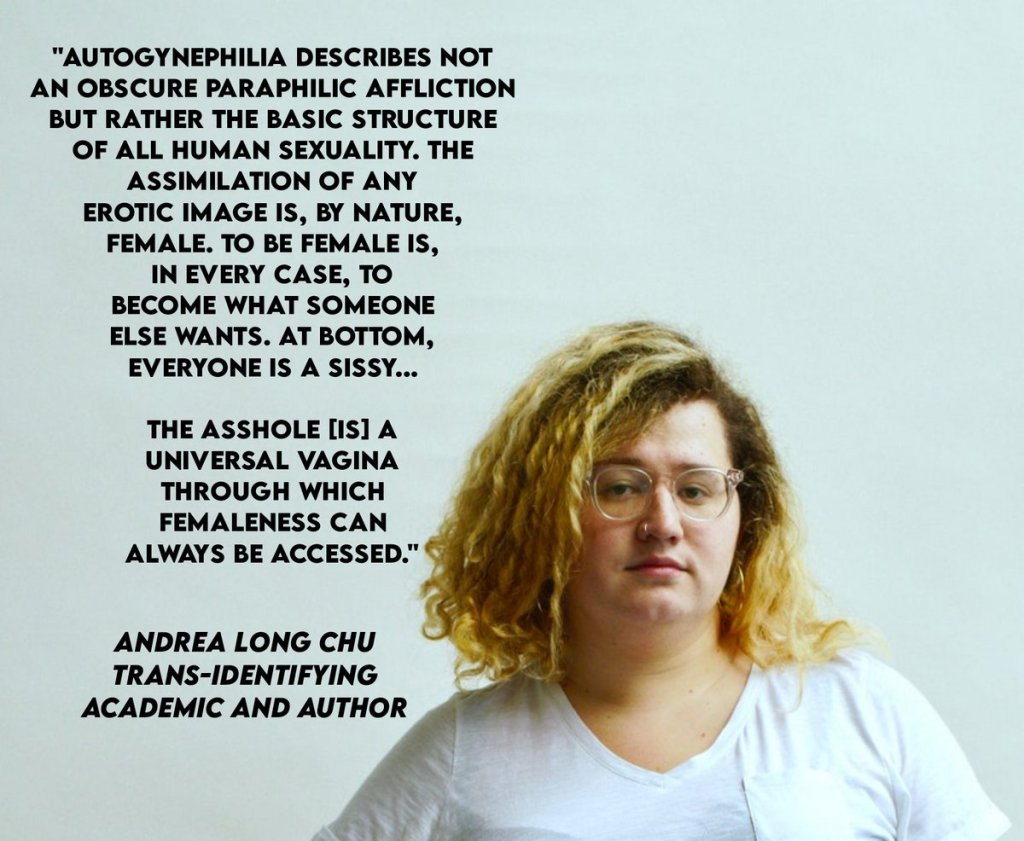

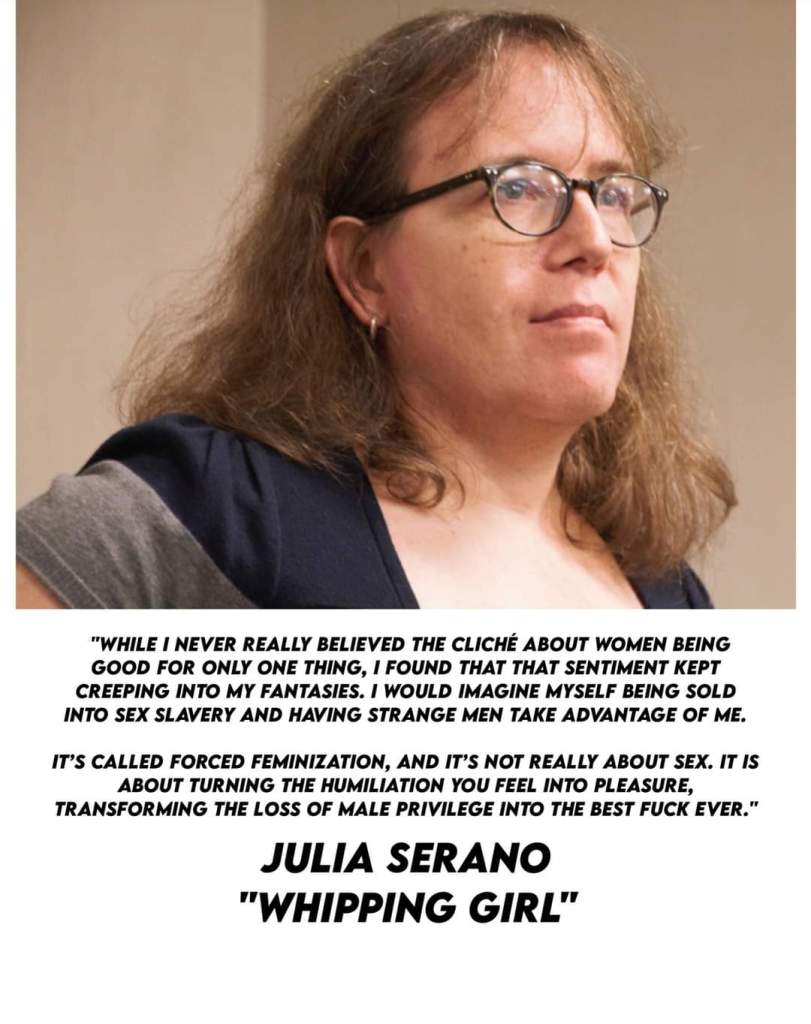
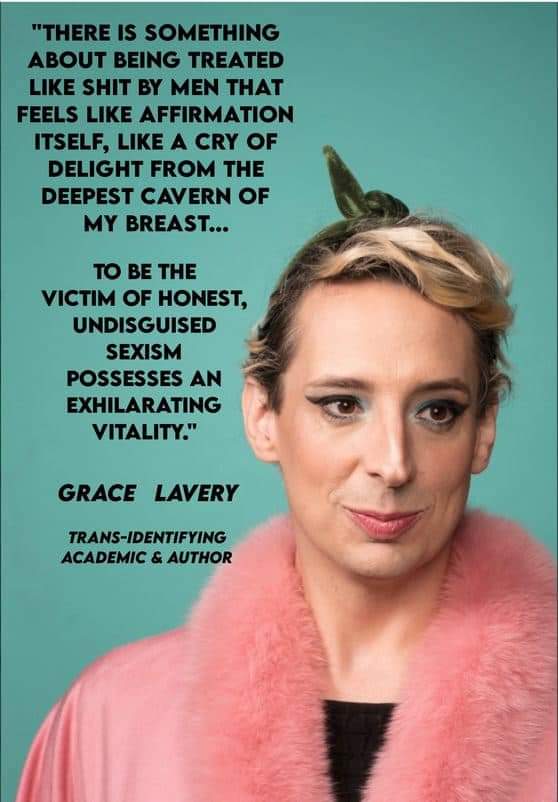
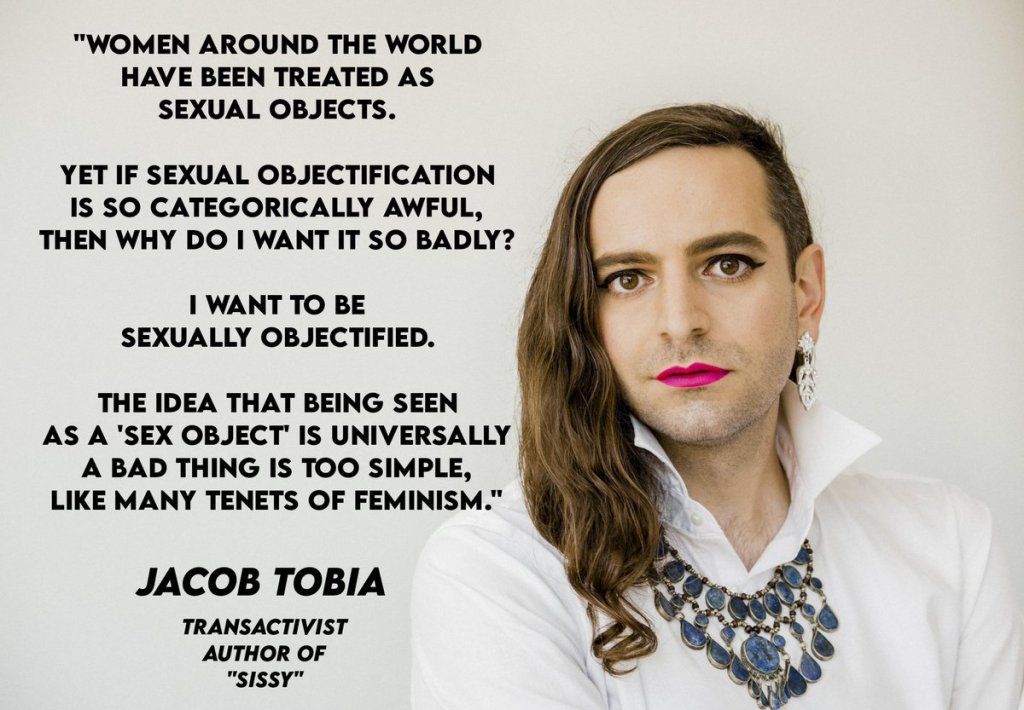
A feminist review of “Females”: Desire as Dehumanization: A Review of ‘Females’ Continue reading Desire as Dehumanization: A Review of ‘Females’ | Women Are Human.
The defence of “kink” and BDSM is the key to understanding trans-queer politics today. Kink includes things like “breath play” (strangulation), “age play” (simulated paedophilia), “rape play” or “consensual non-consent” (rape), “race play” (eroticising racism and degrading steretoypes), ABDL (adult baby diaper lover, a form of autopaedophilia), DDLG (Daddy Dom Little Girl) and more. BDSM is sexual abuse. It’s a form of grooming, where “no” doesn’t mean “no”, and vulnerable, traumatised people are led incrementally to “consent” to abuse and rape. Johns in Germany have the option to urinate and defecate on prostituted women in brothels, while queer theorists are fighting for a woman’s right to choose “sex work”. Women are being strangled to death and blamed for wanting it through the “rough sex defence”: https://twitter.com/Wecantconsentto
But ironically, defenders of queer theory are right when they say it’s not primarily about sex. It’s actually about capitalism, consumerism, monopolies and profit. It’s true that you will find radical-𝘴𝘰𝘶𝘯𝘥𝘪𝘯𝘨 critiques of neo-liberalism, homonationalism and pinkwashing in such queer thinkers as Butler and Nair, but queer theory is ultimately a neo-liberal or anarcho-capitalist ideology that turns identity into a commodity. Pinkwashing or rainbowwashing by corporations for profit is the whole point. See the image below. See also:
<<On April 24, 2006, Judith Butler, who became the most famous living queer theorist by taking Foucault’s idea of sexuality as a social construct and applying it to gender, spoke at a “teach-in” at UC Santa Cruz against the Iraq War.22 Calling it a “teach-in” was a deliberate choice, an homage to the New Left radicalism of the Vietnam protests. But something had changed. During the Vietnam War, it had been the students who led the teach-ins; now, it was the professionals, professors like Butler, as well as politicians, lawyers, and in this case, a former diplomat named Joseph Wilson. Wilson had worked in the Iraqi embassy before it closed during the first Gulf War and was the last diplomat to meet with Saddam Hussein. The CIA had previously sent him on a fact-finding mission to Niger to investigate whether Saddam had purchased yellow-cake uranium from that country. The dictator of Iraq had not, and Wilson wrote as much in the New York Times.
But Wilson was not there because of an op-ed in the Times nor because he was a former diplomat; he was there because the Bush administration had outed his wife as an undercover CIA operative. It is difficult to imagine the student radicals of the Vietnam War era inviting a man who had openly worked for the CIA to speak at one of their teach-ins.>>
– The CIA and the New Dialect of Power. The entire article is very eye-opening, well worth reading.
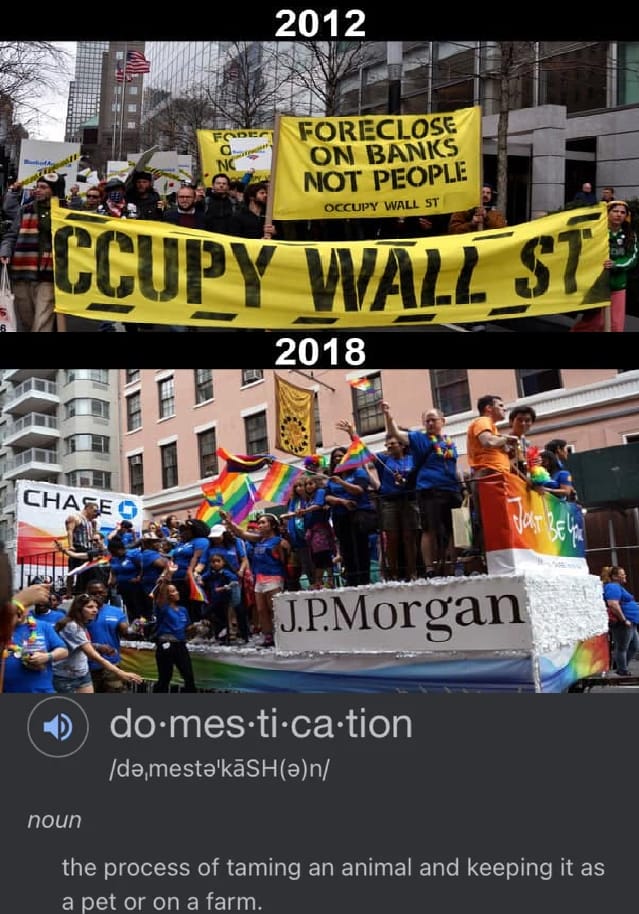
Foucault was openly neo-liberal towards the end of his life, and never was a Marxist or leftist.
Queer academics regularly come out with articles arguing that johns (men who buy sex) are queer, hetereosexuals who “feel” deviant in some way are queer, and even that drone operators are queer! This is all because queer theory is the very pinnacle of neo-liberalism.


Also interesting is the history of paedophilia apologetics and experiments by sexologists embraced by the self-described “left”.
Other sexologists who defend paedophilia lean quite conservative (of course Foucault criticised the whole project of psychology and scientific descriptions of human behaviour, some of it a valid critique), like John Money, the Man who Invented Gender in the 1950s and psycho-sexually abused children (the most famous case being David Reimer and his twin brother, who later committed suicide) for his experiments, and today, James Cantor who openly argues that P should be added to the LGBT+ acronym. But conservative vs liberal is an entirely false dichotomy. It is obvious that queer theory is conservative, because it tries to preserve inequalities in power, and advocates for the “rights” (read: privileges) of dominant groups. And conservatives are liberal, or neo-liberal, since liberalism is the ideology of capitalism.
This article critiques identity politics, including queer and gender identity theory, from a Marxist perspective:
<<Assigning people to reified identities, which are constructed as their innate and defining properties, is, therefore, an essential element of how oppression is systematised to aid exploitation. Reification, as explained by Hungarian Marxist George Lukács, has the effect of hiding the reality of capitalist exploitation from the workers, of making the system created by capitalists appear innate and natural. It is only by exploiting the limitations of capitalist commodification and overcoming reification that we can overthrow the capitalist system.[6] Since oppression is not a separate phenomenon from exploitation but a support for the exploitative system, it is surely impossible to regard the results of reification as a route out of oppression. If you are in chains, declaring that they are kinky and empowering is unlikely to set you free.
Identity politics and intersectionality
It is in these reified identities, however, where identity politics do indeed look for liberation. The roots of identity politics lie in the development of postmodernist politics in the 1980s and 1990s. In essence, postmodernism argues that material reality is a positivist delusion. There are no objective circumstances, only different subjective realities constructed through words, images and ideas. When applied to struggle, these ideas indicate that fighting according to your material relation to the means of production – whether you control capital or have to sell your labour to live – is to miss the point. Old-fashioned socialists might still have been grubbing around at the economic base, organising working-class struggle, but those enlightened by postmodernism looked to the ideological superstructure. Here, the agents of change in society became not the working class but those oppressed on cross-class, ideological bases like sex, race or sexuality.
In the context of the rise of neo-liberalism and major defeats for the Left like the Miners’ Strike of 1984-5, it’s easy to see how a politics located in the realm of signifiers rather than the material realities of exploitation might have seemed attractive. If you doubt your ability to change the world, you might wish, as A Sivanandan put it in his critique of postmodernist politics, to amend Marx’s famous phrase and state that while philosophers have interpreted the world, ‘our task is to change the interpretation.’>>
Doesn’t that “+” and all the rhetoric about being “entirely inclusive” and practising “acceptance without exception” look sinister now! Even if you remove the +, paraphiles, fetishists, kinksters and abusers of all stripes are included under the Q.
Queer theorists also advocate for full decriminalisation/legalisation of prostitution, including for cpimps, johns and brothel keepers. They attack survivors of sex trafficking and sex slavery, women who have exited the sex trade who call for insituting the Nordic Model (which criminalises sex buyers but not prostituted or trafficked women) as “SWERFs”.
Queer theory exists in the intersection of child exploitation and capitalism. Commercial child sex exploitation is very profitable.
Adult prostitution is inseparable from child sex trafficking and exploitation; a huge proportion of women in the sex trade enter prostitution when they are minors:
<<We explored associations between features of the risk environment, sex work and drug use history, and underage sex work entry among 624 female sex workers(FSWs) in Tijuana and Ciudad Juarez, Mexico. Forty-one percent (n=253) of women began sex work as minors>>
<<The benefits of economic globalization, internationalization, and free trade have brought with them an unanticipated set of social problems … Among them is what appears to be a dramatic rise worldwide in the incidence of child exploitation. Among the most virulent forms of this exploitation is child sexual exploitation …including the commercial sexual exploitation of children … Child pornography, juvenile prostitution and trafficking in children for sexual purposes have emerged as significant problems on the national, regional, and international stages … So, too, has sex tourism … CSE and the CSEC appear to be related in complex ways with other forms of child exploitation, such as the use of children in labor, drug and warfare settings.
Patterns in the commercialization of sex, whether it is in the form of formal monetary exchanges or informal exchanges of goods and services, ratchet up the abusiveness of the relationship between the child and the trafficker and/or customer. The commercial nature of the relationships pile all the forces of economic interaction (value, profitability, return on investment, payment and pay back) on top of the physical and psychological coercion, duress, and deception that already permeate the sexually abusive relationship. In short, commercialization creates a dense layer of interpersonal enthrallment that is extremely difficult to battle against on behalf of child protection.
Listed in the order of frequency with which they have been identified in the scholarly literature, child sexual exploitation appears to be fueled by: 1) the use of prostitution by runaway and thrownaway children to provide for their subsistence needs …; 2) the presence of pre-existing adult prostitution markets in communities where large numbers of street youth are concentrated …; 3) prior history of child sexual abuse and child sexual assault …; 4) poverty …; 5) the presence of large numbers of unattached and transient males in local communities–including military personnel, truckers, and conventioneers among others …; 6) for some girls, membership in gangs …; 7) the promotion of child prostitution by parents, older siblings and boy friends …; 8 ) the recruitment of children for prostitution by organized crime units …; and, increasingly, 9) illegal trafficking of children for sexual purposes both within and to the U.S. from developing countries located in Asia, Africa, Central and South America, and Central and Eastern Europe>>
German psychologists and the scientific case against prostitution
<<Prostitution is in no way a job like any other. It is degrading, torturous, exploitive. On the side of the prostituted, there is a lot of horror and disgust at play, which they have to repress in order to get through it at all.” So says Michaela Huber, psychologist and head of the German Society for Trauma and Dissociation.
“In this system of prostitution, women are systematically put down, used, and degraded into objects.” So says Lutz Besser, head of the Centre for Psychotraumatology and Trauma Therapy of Niedersachsen.
“Prostitution has its roots in the violence that is done to children. And society must not block out or whitewash this violence!” So demands Susanne Leutner, vice-president of the trauma-therapists’ association, EMDRIA>>
A case study in commercial sex exploitation of children, in the Indian caste that traditionally practises prostitution:
<<In the morning, 12-year-old Maya Lal plays with her dolls. She no longer goes to school. Instead, as soon as the sun sets, she retreats into a room with her father’s “friend.”
Maya is not the only 12-year-old engaged in such work. In the Ratlam district of the central Indian state of Madhya Pradesh, when a first-born daughter of the Banchhara tribe turns 12, her father organizes a ceremony where she makes known her intentions to work as a prostitute. After this declaration, her father takes her to her first customer, who waits in a room in her family’s house reserved for this purpose.
“My father has told me that I have to do this work because it is part of our custom. So I don’t mind,” Maya said.
Young Banchara girls such as Maya may entertain up to six clients each day. Fathers and brothers live off the earnings of their daughters and sisters, who make between $10 and $100 each day, according to the Madhya Pradesh Human Rights Commission, an affiliate of India’s National Human Rights Commission. The agency submitted recommendations last year to government officials about ending the practice. Since Indian law prohibits prostitution, the industry is unregulated by health or business officials, and more than 90 percent of these pre-teen prostitutes become pregnant. Many others are infected with sexually transmitted diseases, including AIDS, the commission found.>>
Another article on CSEC in India, with statistics on the growth of the industry:
<<Even before she’d reached puberty, Suchitra had learned different sexual positions and other ways to please a customer.
At age 14, a man she had never seen before showed up one day at the family’s house near Bharatpur in northern India. At her mother’s urging, Suchitra got into his car. Six hours later they reached their destination. It was a brothel in New Delhi’s red-light district. She had been sent into sexual servitude.
“I always knew that this would be my life,” says Suchitra, sitting in her wardrobe-sized room and wearing a low-cut green top and jeans, her hair pulled back in a tight bun. “I can never forget what I’ve done but it is the only way for my family to earn a living.”
Suchitra, now 20, is from one of hundreds of villages in India where centuries-old tradition dictates that most girls enter into a life of prostitution. Rising wealth hasn’t reduced the trafficking of girls for sex in the world’s second-most populous nation: the number of child prostitutes is growing and the average recruitment age has dropped to between 9 and 12 years old, according to the Delhi-based National Human Rights Commission.
“We are witnessing an unprecedented growth in prostitution,” says K.K. Mukherjee, a sociologist who has studied sex workers for more than three decades and has written government reports on the subject. “It is being driven by rising levels of income but also by a change in sexual attitudes and the increasing migration of women to cities.”
Districts such as Bharatpur, where half of the women are illiterate, are breeding grounds for the country’s $4-billion sex trafficking industry. India has 3 million sex workers, of whom 1.2 million are below the age of 18, according to a government estimate. The South Asian nation traffics more women for sex than any other country.>>
Photographs of children exploited for sex in India:
“Here are some amazing photographs of some very young Bedia girls, some of which are already prostitutes with the rest nearly certain to do the same soon. First are photographs of Sanjana and her younger sister Simran (6). Sanjana’s age is unknown, though she claims to be 18. Simran is expected to enter the profession as soon as she reaches puberty.”
Pornography is part of the sex industry; many of the women and children abused in porn come from prostitution. There was a recent campaign to ban Pornhub, which allowed videos of minors being raped to be uploaded and viewed millions of times.
Three more excellent articles on pornography, sexual violence, and capitalism:
https://cease.org.uk/facts/culture-the-air-we-breathe/whats-porn-got-to-do-with-sexual-violence/
https://fightthenewdrug.org/study-evaluated-7430-videos-on-mainstream-porn-sites-found-aggression/
https://www.truthdig.com/articles/pornography-is-what-the-end-of-the-world-looks-like/
<<Of the domestic minor trafficking victims who had been forced into porn, the average age they began being filmed was 12.8 years old.
(TVPA, 2000; Thorn, 2018)>>
– from the anti-porn group Fight the New Drug.
Queer theory is neither radical nor leftist. It is deeply conservative, capitalist, neo-liberal and regressive. It fights in the interests of the powerful, promoting their rights to abuse the powerless. The real left – the real radicals – are anti-capitalism, anti-prostitution and anti-child sexual exploitation (both commercial and non-commercial forms).
Leftists who support prostitution, pornography, surrogacy, queer theory and gender identity theory are PEWAC, or “Progressive Except for Women and Children”. When it comes to women and children, they become liberals, sexual capitalists, right wing.
Robert Jensen explains how radical feminism is leftist:
<<The political left, and much of mainstream feminism, is characterized by an analysis of how systems and institutions shape our choices, a critique of capitalist media, and a commitment to a scientific/materialist worldview. But when faced with radical feminism’s compelling critiques of patriarchy, leftists and many feminists routinely abandon those principles. Radical feminist critiques of prostitution, pornography, and transgender ideology should be part of a consistent, coherent left analysis.>>
Women who fight for the abolition of prostitution, very often survivors of prostitution/trafficking, are routinely called “SWERFs” and “whorephobes”, by (mostly) leftist and liberal men, including men who identify as Marxist:
<<I do expect most people reading this to have even a basic sense of history, logic, and ethics — which is all you need to realize how stupid the idea of pro-prostitution Marxism is.
…
But if there’s one thing more audaciously anti-communist than the historical revisionism of pro-prostitution Marxists, it’s their mangling of Marxist theory to justify the sale of women’s bodies.
The ones I’ve spoken to — online and off — are quick to trot out the same (false) liberal slogans: The Nordic Model doesn’t work, legalization reduces trafficking, prostituted women can form unions, et cetera. They might throw in a buzzword like “autonomy” or “consent,” as if Marxism even allowed for those notions to be coherent inside capitalism, imperialism, and settler colonialism.
…
Tell me, what is the difference between this supposedly progressive, radical Marxist vision and any other cut-rate men’s rights activist? The view of any human being as a means of production is fundamentally anti-communist. If anything, it’s the pure distillation of a capitalist logic that seeks to treat humans as resources.
The fact that so-called Marxists are aligning with conservative anti-feminists in viewing sex as a resource produced by female bodies for male consumption speaks to the dismal state of a truly revolutionary socialism.
Practically, these so-called communists (they’re really sexual capitalists) are always shy about exactly how prostitution would function in a communist society. And they should be, because any honest answer is horrifying.
…
Marxist support for prostitution betrays the entire core of the communist project — to create a society in which no one lives by the exploitation of another. It ignores the rich history of communist resistance to women’s exploitation; it mangles the ideology of Marx to justify a level of objectification even most capitalists can’t match; and it fails to provide an even basic explanation for how this utopic worker’s sex industry could even function in the absence of rape and trafficking.
…
There’s just no way to conceive of sex as work without reducing women’s bodies to a sex-producing machine to be operated by men, and we certainly don’t need Marxists championing a vision that celebrates the commodification of our relationships and treats human bodies as means to an end. We already have it. It’s called capitalism.>>
The real left has always been anti-prostitution, anti-pornography, and anti-child abuse, because we oppose the exploitation of all human beings, everywhere:

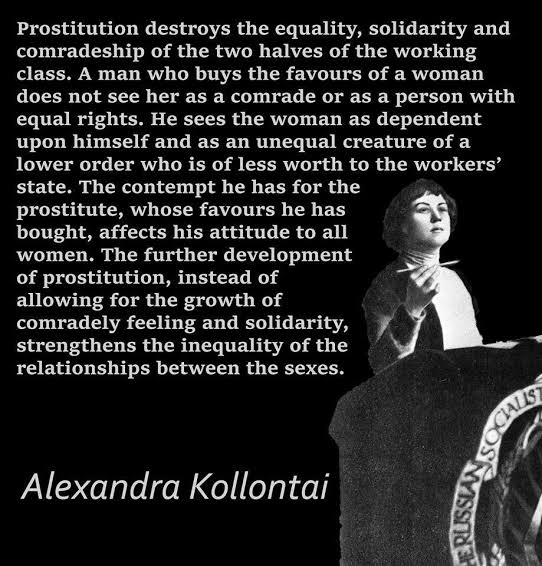
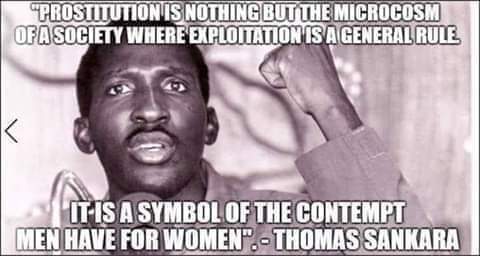
South African socialists call for the abolition of prostitution.
These are the women who are labelled “SWERFs” and “whorephobes”.
Why sex work is not work
The following article shows how demand for prostituted women went up after legalisation in Spain. Previously, the “clients” were older men, and after legalisation, it became a sort of male-bonding activity for groups of young men. The “sex work is work” discourse and calls for full decriminalisation of all parties, including pimps, johns and brothel owners, is not intended to reduce stigma against exploited women in women in prostitution but to reduce stigma against the men who exploit them. And it has worked. (I’ve seen an academic paper arguing that men who buy sex are queer.) Obviously, when demand increases so much, those in the business must find ways to increase the supply as well. Do you really think there are so many women who freely choose sex work?
An estimated 90% of women in the sex trade in Spain after legalisation of prostitution are victims of trafficking from poorer countries.
The remaining 10% may not have been literally trafficked, but certainly the vast majority of them had no choice – they were driven to enter the sex trade by poverty. Men who pay for sex are taking advantage of these women’s poverty if not actively exploiting enslaved women.
How women in prostitution are controlled by pimps and traffickers (one woman’s experience)
<<The Invisible Men project shows you words used by men to review their experiences with women in prostitution. Without seeking to prove, disprove, or debate choice on the part of the women described, you are invited to consider: what do you think of HIS choice?>>
– The Invisible Men Project
<<A study from University of California, Los Angeles (UCLA), claims that men who have sex with female sex workers feel less empathy for them than men who do not buy sex. Part of this reason is due to the fact that they view them as “intrinsically different from other women,” according to the authors.
The study also reported that men who buy sex are more likely themselves, to have raped or committed violent sex acts against women.>>
– Men who buy sex share ‘key characteristics’ with aggressive sex offenders, study claims
Prostitution is paid rape. We talk about the importance of “free” consent, and with the Me Too movement, recognise that men who demand sex from their female employees as a condition of career advancement are taking advantage of them. We recognise there are difference in power, which makes any consent in that situation meaningless. So why do we not extend that same analysis to poor women in prostitution?
<<Perhaps the single most effective strategy hit upon so far is to pump out the myth contained in the term “sex work”: the myth that it is possible to commodify consent.
How can sexual consent be a thing that can be bought and sold, yet we can still talk with a straight face about there being such concepts as healthy sexual relationships and meaningful consent?>>
See also this article on Anti-Imperialism.org that talks about the role of so-called “sex-positive feminism” (a branch of queer politics) in the rampant neo-liberal commodification of sexuality through kinks and fetish gear, for example. The article is written from an anti-imperialist, anti-capitalist perspective, and makes the connection between Western child-sex-tourism in the Third World and so-called “sex-positive” (really it should be called “abuse-positive”, or “rape-positive”) politics:
<<We see that there is big money to be made in the commodification of sexuality. It’s not just the explicit depictions of nakedness sold to fetishistic consumers as a masturbatory and social ideal, but everywhere the mantra “sex sells” is employed. Everywhere oppression eroticized and money collide. Everywhere Sadian freedoms open up new markets and revitalize old ones. Pornography, makeup, fashion, contraception, advertisement, alcohol, bars, clubs, and so on construct a capitalist raunch culture where sex is profitable and more sex is more profit. Capitalist society has even popularized a new type of sex, “kink”, where one must buy harnesses, ball-gags, whips, and all manner of commodities to aid in heightened sexual violence. The possibility of a uniquely capitalist sexuality is not just due to capitalist relations of production, but also to capitalist forces of production.
…
What Dworkin is describing here is wimmin’s status as “commodities” in a sexual sense. The institution of marriage and that of “prostitution” are–in one sense–ultimately the same; distinguishable only by the moral compass of the right wing, or by the period of exclusivity and number of owners. The “left-wing” notions of “freedom” that Dworkin notes here were thrown out into the open, directly challenging the alternative “right-wing” method for sexual domination. In this sense, the modern view of sexuality does not really challenge the basic notion of what womynhood is: the state of being owned, used, or valued solely on the basis of existence as a sexual thing for men. What we have is merely a new interpretation of the old premise. In this way, wimmin can be freed from the kitchen, freed from the bedroom, and freed from the laundryroom, yet with ultimately no real consequence to their character. They are still wimmin, they still are valued as wimmin and in this line of thinking their responsibility, their social utility, is based on their ability to be sexually available to men; whether monopolized or democratized.
“Sex-positive feminism”, or in other words Dworkin’s “Left”, sought to position itself at the forefront of the evolution of patriarchy into something befitting the needs of modern political economy. It is distinctly liberal with its dismissal of collective struggle in favor of individualism and store-bought conception of wimmin’s liberation, and distinctly First Worldist with its complicity in furthering patterns of international exploitation with explicit or implicit support for sex tourism. With the global division between what has become the “marketplace of the world” in the First World, and the “storehouse and factory of the world” in the Third World, there is the perfect environment for new patriarchal relations to be the further advanced by liberal political movements. For example, ‘kink’ as a rather new development in contemporary “late-capitalist” sexuality, has been totally marketized. Established as an entirely new industry with its own marketable subculture, it has fed into the larger system of consumer gratification which is possible only in the First World at its current scale. Although these things of course exist in all corners of the globe, 𝘁𝗵𝗲 𝗲𝗽𝗶𝗰𝗲𝗻𝘁𝗲𝗿𝘀 𝗼𝗳 𝘁𝗵𝗲𝗶𝗿 𝗱𝗲𝘃𝗲𝗹𝗼𝗽𝗺𝗲𝗻𝘁 𝗶𝗻 𝘁𝗵𝗲 𝗧𝗵𝗶𝗿𝗱 𝗪𝗼𝗿𝗹𝗱 𝗵𝗮𝘃𝗲 𝗯𝗲𝗲𝗻 𝗳𝗼𝘀𝘁𝗲𝗿𝗲𝗱 𝗮𝗿𝗼𝘂𝗻𝗱 𝘁𝗵𝗲 “𝘀𝗲𝘅-𝘁𝗼𝘂𝗿𝗶𝘀𝗺” 𝗵𝗼𝘁𝘀𝗽𝗼𝘁𝘀, 𝘄𝗵𝗶𝗰𝗵 𝗮𝗿𝗲 𝗯𝘂𝗶𝗹𝘁 𝘁𝗼 𝘀𝗲𝗿𝘃𝗲 𝘁𝗵𝗲 𝗰𝗼𝗹𝗼𝗻𝗶𝗮𝗹𝗶𝘀𝘁 𝗮𝗻𝗱 𝗰𝗵𝗶𝗹𝗱-𝗵𝘂𝗻𝗴𝗿𝘆 𝗺𝗲𝗻 𝗼𝗳 𝘁𝗵𝗲 𝘄𝗲𝘀𝘁. The way that this correlates with the accusation of First-Worldism on the part of the liberal and “sex-positive” feminists of the global north is in the manner by which they extol these developments of “individual liberty” as being congruent with the needs for wimmin in the global south to achieve liberation, in total denial that this system constructed in the First World not only requires the subjugation of the south to accomplish, but further it has not produced any less of a violent and patriarchal society in the First World.
But to really delve deeper into what “sex-positive feminism” is at its core, we can look to defenses or explanations of the principles of “sex-positive feminism” from the proponents of it themselves. They all tend to converge toward the same basic argument, that of the centrality of the issue of “s–t shaming” [hereafter “sex shaming”]. For example, one such explanation of the basic tenets states that:2
< Essentially, sex-positive feminists argue that people should be able to engage in various sexual acts and have various sexual preferences free of shame as long as those preferences and acts are safe and consensual. By achieving sexual liberation, women cannot be shamed for their natural desire for sex which consequently mitigates social oppression.
Slut-shaming [sic] is a common issue which sex-positive feminists aim to combat. A succinct definition of slut-shaming by Alon Levy is “the implication that if a woman has sex that traditional society disapproves of, she should feel guilty and inferior”. >
The problem here is not whether sex shaming exists or not–it certainly does–the problem is in trying to understand how sex shaming relates to certain historical processes, what the role of sex shaming is in modern society, and how centering our understanding of liberation on decontextualized persynal choice as the supposed alternative to “sex shaming” actually covers up anti-womyn violence.3
Men will find almost any reason to try and prove that “she really wanted it”, including sex shaming. In this way there are actually two distinct types of sex shaming: one born from an antiquated disagreement with modern sexual developments, and one born from rape culture. The problem arises when these two types are conflated and the whole thing is identified as the central principle of modern sexuality. When the enemy is identified as “traditional [old] society”, rather than every manifestation of patriarchy [new or old], we become little more than inadvertent accomplices for the modernization of patriarchy. When we ignore that the construction of narratives about promiscuity are either an artifact of a dying culture or a servant to the higher cause of rape culture, in favor of an analysis that identifies “sex shaming” as an autonomous social dynamic, we’re not actually getting to the root of the problem.
…
However ‘free’ and ‘liberated’ sexual attitudes have become in the last century, the fundamental nature of our sexual paradigm–that of the eroticization of dominance–remains intact. Subordination through victorian monogamy is now complimented by the wonderful new possibility of subordination through kinky polyamory. Such is the extent of capitalist ingenuity, the breadth of choice offered of the market, the grandiosity of bourgeois freedoms. A great deal of feminist activity has been wasted advancing the logic of capitalist society, rather than fighting for a sexuality truly orthogonal to patriarchy. No doubt new forms of capitalist sexuality are still to come, and no doubt “sex-positive” feminists will be on the front lines.
…
In short, “sex-positive” feminism represents an incredibly stunted view of liberation imported from the advancement of capitalist culture and industry.>>